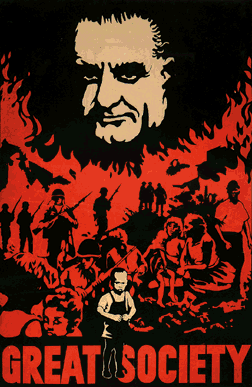|
Chapter summaries
|
Online Chapter: Peace Symbols: Posters in Movements against the Wars in Vietnam and IraqThe New Left, Students, and the Rise of the Peace Movement No force contributed more to the anti–Vietnam War movement in the sixties than the student-based New Left that sparked and spread like a prairie fire. As the 1950s came to a close, virtually no one predicted the sudden upsurge of radical political and cultural energy. But there was at least one major exception, rebel sociologist C. Wright Mills, who believed he was seeing the emergence of a “new left” in America. As the decade wore on, this claim came to seem prophetic as the civil rights movement was joined by student and peace movements to form what became known as the New Left. Much of the “old” left” of the 1930s was tied to the U.S. Communist Party USA. In the thirties communism was a mass movement with deep roots in U.S. traditions and U.S. social concerns, and during World War II the Soviet Union was a key U.S. ally, but by the Cold War of the 1950s anyone associated with communism had become by definition un-American, if not traitorous. Anticommunist hysteria and repression during the McCarthy era of the fifties had rendered largely silenced not only Communists but also virtually any liberal, progressive, or otherwise dissenting voices. Thousands lost jobs just for being indirectly associated with dissenting ideas. Young people soon defied this silencing and took up the challenge of articulating a radically democratic critique of the nation’s failures to live up to its ideals. Later historians would come to see more continuities between the “old left” of the 1930s and the “new” one of the 1960s, but for those riding the emergent wave of activism, “newness” was of great importance in creating a generational identity. The most important groups to emerge as part of this New Left were the radical civil rights organization the Student Non-violent Coordinating Committee (SNCC, see chapter 1) and Students for a Democratic Society (SDS), founded in 1962. SDS’s famous founding document, “The Port Huron Statement,” argued that political repression, the threat of nuclear war, and the consumerist cultural conformism of the fifties had rendered most Americans complacent in the face of their government’s failures to deal with racism, poverty, and the decline of democratic ideals. In place of this quiescence, they called for a “participatory democracy” in which citizens took control over all aspects of their political, economic, and cultural lives. Many early SDS members were veterans of the civil rights movement in the South where they had learned both of the shortcomings of a supposedly just society and how to organize nonviolent direct action campaigns to fight these injustices. They believed idealistically in American democracy and that democracy was far from being fully realized here or elsewhere. SDS argued that America’s ideals were being betrayed by racism, warmongering, and obsession with material wealth. The New Left became a kind of intellectual/activist core that sparked and helped shape the mass movement of students into the antiwar and other progressive movements that grew as the sixties wore on. In its first few years, the mostly white SDS focused primarily on issues of racism and poverty in northern U.S. cities. Their eloquent calls for ordinary people to take control of the institutions that shaped their lives played a role in the formation of a variety of poor peoples’ movements and even shaped what Democratic president Lyndon Johnson (1963–68) called his War on Poverty. But the war in Vietnam overtook the War on Poverty, and the former increasingly became the major focal point for SDS, not least because the cost of Vietnam in monetary and human terms was undermining both liberal and radical efforts to fight poverty and other injustices. Johnson called his wider effort a move to create the “Great Society.” But as Figure 16 graphically illustrates, that Great Society was drowned in the blood of Vietnamese and Americans.
Figure 16.Screen Prints, ca. 1967. Courtesy of Sixties Project. Approximately 3 million Vietnamese men, women, and children died in the war; 58,148 Americans were killed in Vietnam, and another 75,000 were severely disabled. Of those killed, 61 percent were younger than twenty-one. To this day, Vietnam veterans continue to suffer the medical effects of chemicals used in the war, especially napalm and Agent Orange, as well as high levels of post-traumatic stress disorder (PTSD). |
|||

